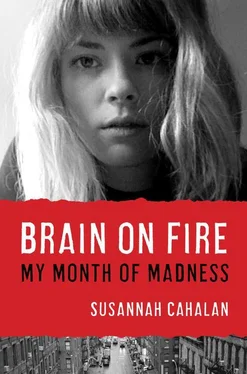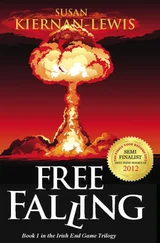When Dr. Russo began to explain that there are treatments that have been proven to reverse the course of the disease, my father nearly sank to his knees and thanked God right there in the hospital room. Still, Dr. Russo cautioned, even once you have a diagnosis, there are still substantial question marks. Though 75 percent of patients recover fully or maintain only mild side effects, over 20 percent remain permanently disabled and 4 percent die anyway, even despite a swift diagnosis. 43And those aforementioned “mild” side effects might mean the difference between the old me and a new Susannah, one who might not have the humor, vitality, or drive that I did before. Mild is a vague and undefined term.
“About 50 percent of the time, the disease is instigated by an ovarian tumor, called a teratoma, but in the other 50 percent of cases, the cause is never discovered,” Dr. Russo continued.
My dad looked at her quizzically. What the hell is a teratoma?
It was probably best that he didn’t know. When this type of tumor was identified in the late 1800s, a German doctor christened it “teratoma” from the Greek teraton, which means monster. 44These twisted cysts were a source of fascination even when there was no name for them: the first description dates back to a Babylonian text from 600 B.C. These masses of tissue range in size from microscopic to fist sized (or even bigger) and contain hair, teeth, bone, and sometimes even eyes, limbs, and brain tissue. They are often located in the reproductive organs, brain, skull, tongue, and neck and resemble pus-soaked hairballs. They are like those hairy, toothy creatures in the 1980s horror film franchise Critters . The only good news is that they are usually—but not always—benign.
“We will need to do a transvaginal exam to see if there are any signs of tumors,” said Dr. Russo. “We’ll also check her over to see if there’s any link with her history of melanoma. If so, we’ll have to move on with chemotherapy.”
“Chemotherapy.” My father repeated the word in the hope that she had gotten it wrong. But she hadn’t.
My dad looked over at me. I had been staring off to the side, disassociated from the exchange, not seeming to gauge the magnitude of the moment. Suddenly, though, at the word chemotherapy, my chest began heaving, and I let out a deep sigh. Tears streamed down my face. My dad ran from his chair and threw his arms around me. I continued to sob without saying a word, as Dr. Russo waited quietly while he rocked me. He couldn’t tell if I understood what was going on or if I was just attuned to the amplified electricity in the room.
“This is killing me,” I said, my voice high yet unemotional, despite the sobs. “I’m dying in here.”
“I know, I know,” he said. With my head in his arms, he could smell the glue on my hair. “We’re going to get you out of here.”
After a few moments, my sobs stopped, and I lay back on the bed, my head against the pillow, staring straight ahead. Quietly, Dr. Russo continued. “Overall, this is good news, Mr. Cahalan. Dr. Najjar believes that there is a possibility that Susannah could get back as much as 90 percent of her former self.”
“We could get her back?”
“There seems to be a strong possibility.”
“I want to go home,” I said.
“We’re working on doing just that,” Dr. Russo replied with a smile.
Over the weeks, I had gone from being a notoriously difficult patient to a favorite, the ward’s “interesting consult” for a host of attending doctors, interns, and residents hoping to catch a glimpse of the girl with the unknown disease. Now that we had a diagnosis that had never before been seen at NYU, young MDs, hardly a day older than me, stared at me as if I were a caged animal in a zoo and made muffled assessments, pointing at me and craning their heads as more experienced doctors gave a rundown of the syndrome. The next morning, as my father fed me oatmeal and chopped-up bananas, a group of residents and medical students arrived. The young man leading the group of nascent MDs introduced my case as if I weren’t in the room.
“This is a very interesting one,” he said, leading a gang of about six others into the room. “She has what is called anti-NMDA-receptor autoimmune encephalitis.”
The group ogled me and a few even let out a few quiet “ooohs” and “ahhhs.” My father gritted his teeth and tried to ignore them.
“In about 50 percent of the cases, there is a teratoma in the ovaries. If this is the case, this patient may have her ovaries removed as a precaution.”
As the spectators nodded their heads, I caught this somehow, and began to cry.
My father bolted from his seat. This was the first time he had heard anything about my ovaries being removed, and he certainly didn’t want either of us hearing it from this kid. A born fighter and a strong man for his age (or for any other age), my dad bum-rushed the scrawny young physician and pointed a finger in his face.
“You get the fuck out of here right now!” His voice bounced around the hospital room. “Never come back. Get the fuck out of the room.”
The young doctor’s confidence deflated. Instead of apologizing, he waved his hand, urging the other interns to follow him toward the door, and made his escape.
“Forget you heard that, Susannah,” my dad said. “They have no idea what the hell they’re talking about.”
That same day, a dermatologist arrived and conducted a full-body skin exam to check for melanoma, which took about thirty minutes because my body is covered in moles. But after a thorough search, the dermatologist concluded that, happily, there was no sign of melanoma. That evening, they wheeled me down, yet again, to the second-floor radiology department, where they would conduct an ultrasound of my pelvis in search of a teratoma.
I am awakened, even though I hadn’t been asleep. I had imagined this moment: the time when I would find out the gender of my child. Momentarily, I think, “I hope it’s a boy.” But the feeling passes. I would be happy with either a girl or a boy. I can feel the cool metal of the transducer against my belly. My chest wall leaps up into my throat in reaction to the cold. It was almost exactly how I imagined it to be. But then again not at all.
Distraught by the first ultrasound, I refused a transvaginal one, the more invasive pelvic examination. Still, even from the imperfect first test, there was good news: no sign of a teratoma. The bad news was that, ironically, teratomas were good news, because those with them tend to improve faster than people without them, for reasons researchers still don’t understand.
Dr. Najjar arrived the next morning alone and greeted my parents as if they were old friends. Now that they had identified the disease, and knew that there was no teratoma, it was time to figure out what treatment could save me. If he miscalculated, I might never recover. He had spent the night deliberating about what to do, waking up in sweats and rambling to his wife. He had finally decided to act with abandon. He didn’t want to wait for things to worsen; I was already too close to the edge. He delivered the plan of action while tugging at the corners of his mustache, deep in thought.
“We’re going to put her on an aggressive treatment of steroids, IVIG treatment, and plasmapheresis,” he said. Although he had a terrific bedside manner, sometimes he expected his patients to follow him as if they were trained neurologists.
Читать дальше













